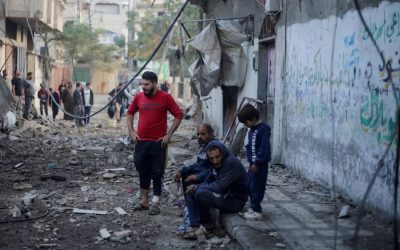War on Gaza Will Last a Year at the Very Least
Israel's planned ground campaign in southern Gaza is expected to last months, even up to a year, while the overall campaign has no clear end date.

All Global Research articles can be read in 51 languages by activating the Translate Website button below the author’s name (only available in desktop version).
To receive Global Research’s Daily Newsletter (selected articles), click here.
Click the share button above to email/forward this article to your friends and colleagues. Follow us on Instagram and Twitter and subscribe to our Telegram Channel. Feel free to repost and share widely Global Research articles.
***
On Friday 1 December, a seven-day ceasefire ended, allowing the exchange of captured women and children by both sides. Many hoped that this break in fighting would be extended and possibly even lead to a permanent ceasefire.
But Israel firmly intends to continue the war until Hamas is “eliminated”. To achieve that goal, it plans a military campaign that will last a year or more, with the most intensive phase of the ground offensive continuing until early 2024. Several people familiar with its preparation told Financial Times.
Israel says it wants to kill the three main leaders of Hamas in Gaza: Yahya Sinwar, Mohammed Deif and Marwan Issa. In addition, it says it wants to secure a “decisive” military victory against the group’s fighting battalions and underground tunnel network.
“This will be a very long war. … We’re currently not near halfway to achieving our objectives,” said a person familiar with the Israeli war plans.
The duration of the war will depend on operational progress on the ground, international pressure and opportunities to free Israeli hostages.
The renewed intensive ground operation focusing on northern Gaza is estimated to last until early 2024. According to one insider,
“Gaza City isn’t finished yet, nor fully conquered. It’s probably 40 per cent done”.
At the same time, the Israeli army will launch a ground offensive in southern Gaza, which has so far only been hit by sporadic air strikes. According to Israeli officials, that is where the majority of Hamas fighters and leadership are now located, as well as most of the remaining Israeli hostages.
The southern ground offensive would be less intensive, at least that is what insiders claim. They probably say this to get world public opinion on their side as much as possible and to appease Washington. The White House wants Israel to have “a smaller military footprint” in the south of Gaza than in the north, i.e. fewer civilian casualties.
According to these insiders, the southern ground offensive, which has now begun, will mainly focus on Khan Younis, an urban centre in the south, and Rafah, the southernmost point of the strip where the border crossing with Egypt is located.
Here, the Israeli army wants to tackle the underground smuggling tunnels that are “the main oxygen channel for Hamas rebuilding its military capabilities”, one of the Financial Times sources said.
The Israeli war strategy seems clear, but there is no sign of an exit strategy or a plan for how to proceed in Gaza after the siege. Israeli officials indicate that they want to permanently eliminate Hamas as a threat at all costs, regardless of how long that takes and what comes next.
One of the people familiar with the war plans puts it this way:
“The main difference [now] is that Hamas doesn’t understand — we have patience. Everything changed on October 7”.
It cannot be ruled out that the ultimate goal of the operation is the deportation of the entire population of Gaza. The elimination of Hamas would then be the excuse and the events of 7 October the ideal trigger.
After two months of intensive bombing and siege, more than 17,000 Gazans have died, including 6,600 children and 4,300 women. Another 3,500 children are missing. They are believed to have been crushed under the rubble of collapsed buildings. It is not without reason that UN Secretary General Guterres says that “Gaza is becoming a graveyard for children”.
On the Israeli side, 94 soldiers were killed in the past two months.
Since the end of the ceasefire, more than 2,000 Palestinians have already been killed and a multiple injured.
*
Israel is in the grip of an unbridled war fever for revenge that is producing apocalyptic scenes. The ruthless lust for destruction tries to heal the wound and violated honour of October 7, in vain. It is an illusion, and even a dangerous illusion, that this decades-long conflict can be settled with arms.
Or as 18 former French ambassadors put it,
“Hamas, which has already been targeted by five deadly military campaigns, will inevitably rise again. The army will not be able to defeat a movement supported by a large part of the Palestinian population, in Gaza as well as in the West Bank.”
Sustainable security for the country can only come if all residents of the territory are recognized as equal citizens, deported Palestinians can return to their country and the colonial occupation comes to an end.
After two months of fighting, more than 16,000 people have now been killed. In the event of a prolonged conflict, the death toll could possibly rise to many tens of thousands. That is why pressure on Israel, both diplomatically and economically, must be started as soon as possible. This is the only way we can stop this madness. It was only in this way that the other apartheid state, South Africa, came to an end.
*
Note to readers: Please click the share button above. Follow us on Instagram and Twitter and subscribe to our Telegram Channel. Feel free to repost and share widely Global Research articles.
Marc Vandepitte is a Belgian economist and philosopher. He writes on North-South relations, Latin America, Cuba, and China. He is a regular contributor to Global Research.
Featured image source

